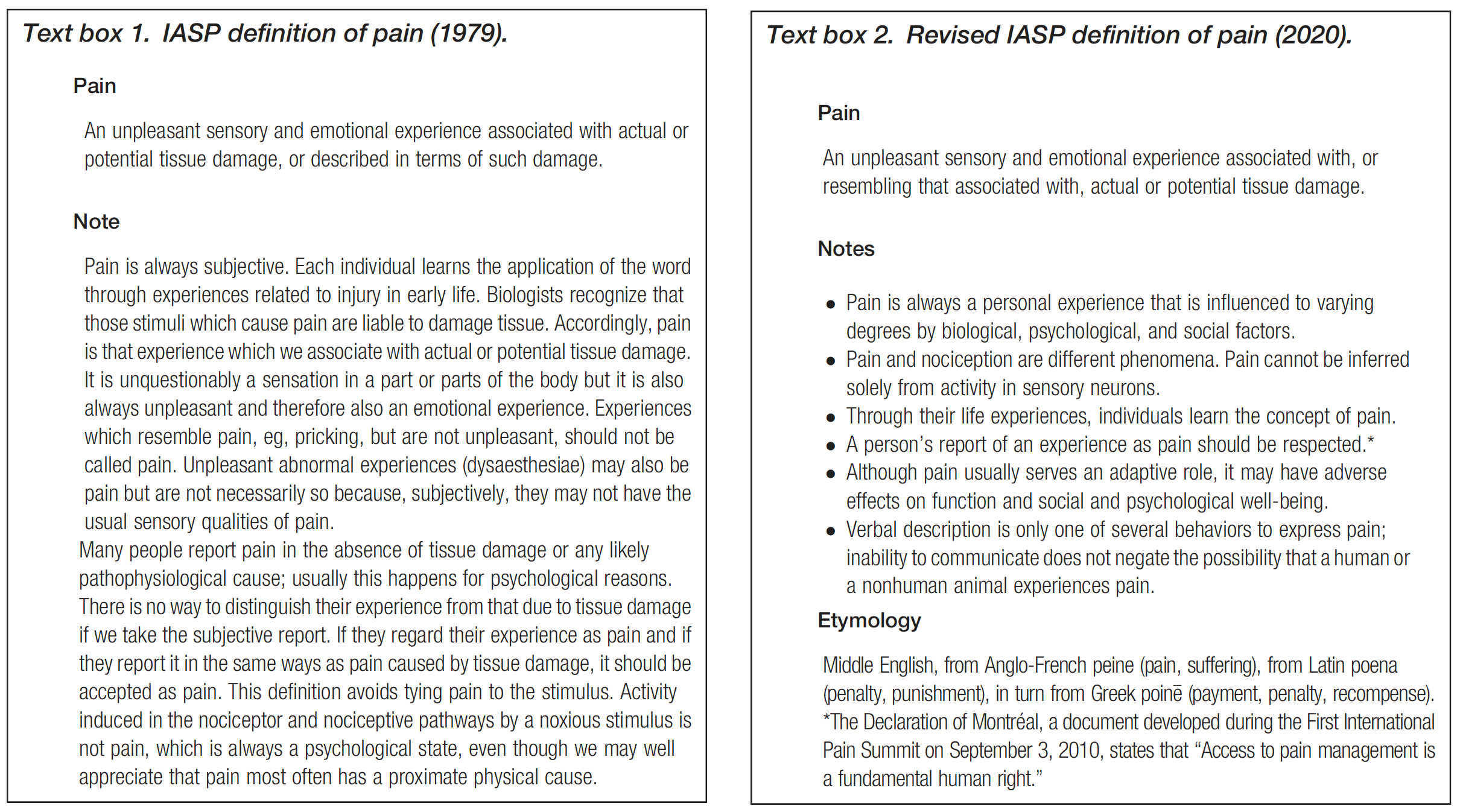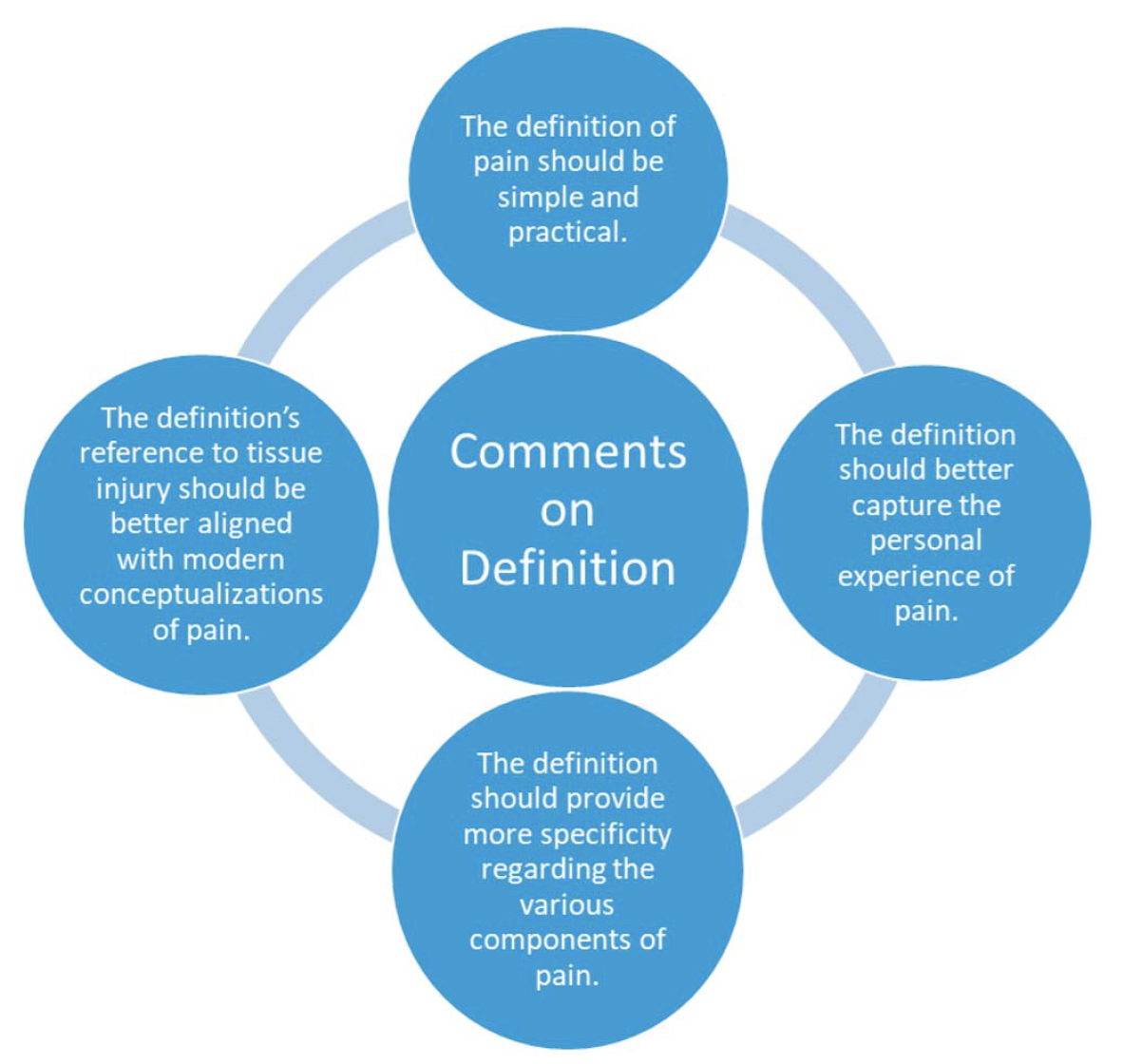The IASP has recently released a revised definition of pain. The definition developed and adopted in 1979; An unpleasant sensory and emotional experience associated with actual or potential tissue damage, or described in terms of such damage has, after two years of much discussion and debate, been revised to An unpleasant sensory and emotional experience associated with, or resembling that associated with, actual or potential tissue damage.
Here they are side by side. It feels a bit like playing one of those spot the difference games….

The Notes have undergone a lot of change though.
A narrative review The revised International Association for the Study of Pain definition of pain; concepts, challenges and compromises available open access here makes for an interesting read.
During a one year public consultation period, the committee received 808 responses from people across 46 countries on the proposed revision; An aversive sensory and emotional experience typically caused by, or resembling that caused by, actual or potential tissue injury. About 42% were satisfied or very satisfied with this proposed revision, but this was equalled by those who were dissatisfied or very dissatisfied. Of those dissatisfied or very dissatisfied, half were people who identified as having the lived experience of pain, or their caregivers.
Qualitative feedback on the proposed revision was coded and four overarching categories were developed to describe the written feedback. This is summarised in the figure below

It seems to me that the respondents were asking for a definition that was modern, simple and practical, and captured the complexity of pain as a human experience.
Did the IASP task force nail it or blow it?
– Tim Cocks
PS. At least they took this bit out of the Note; Many people report pain in the absence of tissue damage or any likely pathophysiological cause; usually this happens for psychological reasons.
(emphasis added)

Tim, I find the definition to be confusing.
By introducing the term “resembling” in relation to “an unpleasant sensory and emotional experience”, the IASP is implying that not only is there is an iconic experience called “pain” but also there are a range of other experiences that resemble it.
How do others interpret “resembling” in the new definition?
In my opinion, the new IASP definition is terrible.
It is recursive ! (1st mistake)
In a context of absence of actual or potential tissue damage, the segment “or resembling that associated with actual or potential tissue damage” is comparing the experience we are trying to define (pain) to another experience erroneously presumed to be pain merely because that one is associated with actual or potential tissue damage. (2nd mistake)
There is also the possibility that this comparison might be made from a observer’s perspective (depending on how “resembling” is interpreted), and so non-stereotypical expressions of pain in a context of absence of (risk of) tissue damage will result in the pain experience not being acknowledged under that definition. (3rd mistake)
Even “tissue damage” seems inadequate to me, for I think there could be cases of physiological dysfunction without proper “damage”. (4th mistake ?)
I think the IASP should recognize that using recursion or talking about how pain might look like does not contribute to, and may hinder, defining and describing how pain is experienced, when writing a short, concise definition.
The IASP definition failed on being simple and practical due to recursivity (#1). The reference to tissue injury does not seem to me to align with modern conceptualizations of pain due to #2 & #4. It does not seem to me to better capture the personal experience of pain due to #3.
I’ve tried to solve these problems by crafting my own definition: “Unpleasant or distressing sensory experience occurring when the organism perceives a current or imminent body injury or dysfunction.” (I am translating from my french definition so the choice of words might not be optimal.) I wonder how others perceive it and if it can be improved upon.
Patrick, given that we experience sensations, perhaps your definition could be simplified along these lines: “Unpleasant sensation occurring when the organism perceives a current or imminent body injury or dysfunction.”